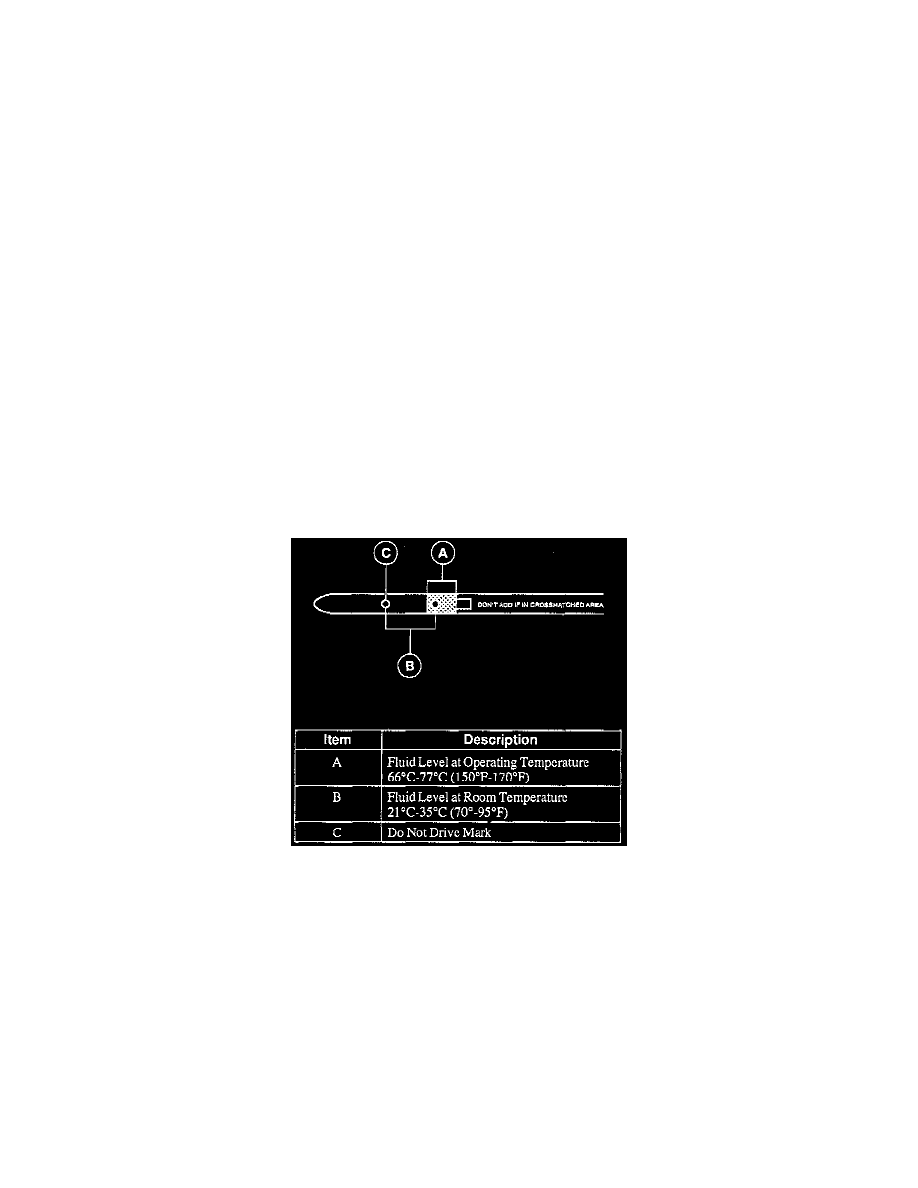F 250 2WD LD Pickup V8-4.6L SOHC VIN 6 (1997)

Fluid - A/T: Testing and Inspection
Fluid Level Check
CAUTION:
-
The vehicle should not be driven if the fluid level is below the COLD marked area on the fluid level indicator and outside temperature is above
10° C (50° F).
-
If vehicle has been operated for an extended period at high speed, in city traffic, in hot weather, or vehicle is being used to pull a trailer, the
fluid has to cool approximately 30 minutes after engine had been turned off to obtain an accurate reading.
Under normal circumstances, check the fluid level of the transmission during normal maintenance, and change it at 48,000 km (30,000 miles) since the
vehicle does not use up transmission fluid. However, if the transmission is not working properly, the transmission may slip or shift slowly or there may
be some sign of fluid leakage. The fluid level should he checked
It is preferable to check the transmission fluid level at normal operating temperature after approximately 32 km (20 miles) of driving. If necessary, check
the fluid level without driving the vehicle, if the outside temperature is above 10° C (50° F).
When checking fluid at normal operating temperature, the fluid level should be within the HOT marked area on the fluid level indicator. When the
vehicle has not been driven and outside temperature is above 10° C (50° F), the fluid level should be within the COLD marked area on the fluid level
indicator.
Check Fluid Level as Follows:
NOTE:The fluid level on the fluid level indicator will be different at operating temperature and ambient temperature. For the correct fluid level
reading on the fluid level indicator, follow the appropriate instructions.
1. With the transmission in Park (P), the engine at curb idle rpm, the foot brakes applied and the vehicle on a level surface, move the transmission
range selector lever through each range. Allow time in each range to engage the transmission. Return to Park (P), apply the parking brake and
block the wheels. Do not turn off the engine during the fluid level check.
2. Clean all dirt from the transmission fluid level indicator cap before removing the fluid level indicator from the fluid fill tube.
3. Pull the fluid level indicator out of the fluid fill tube, wipe it clean, and push it all the way back into the tube. Make sure it is fully seated.
4. Pull the fluid level indicator out of the fluid fill tube again and check the fluid level.
If necessary, add enough fluid through the transmission fluid fill tube to raise the level to the correct position. Do not overfill the transmission.
This will result in foaming, loss of fluid through the vent and possible transmission malfunction. If overfill occurs, excess fluid must be removed.
5. Install the fluid level indicator, making sure it is fully seated in the fluid fill tube.
If the transmission fluid level is checked when the fluid is at ambient temperature, the fluid level indicator could indicate that fluid should be
added if the fluid level indicator is misread. If fluid is added at this time, an overfill condition could result when the fluid reaches operating
temperatures of 66° C-77° C (150° F-170° F) (fluid level indicator hot to touch).
Underfill can result in transmission loss of engagement or slipping. This condition is most evident in cold weather or when the vehicle is parked or
being driven on a hill.
If the transmission fluid level is correctly established at 10-35° C (50-95° F), it will appear in the HOT marked area on the fluid level indicator
when the transmission reaches an operating temperature of 66-77° C (150-170° F). Do not overfill or underfill.
